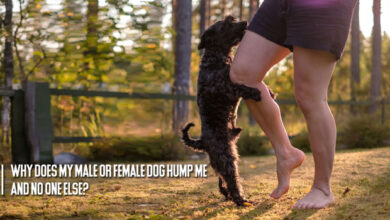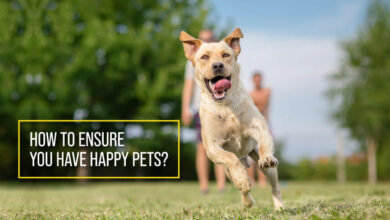How to Find a Lost Dog?
Losing a dog is a profoundly upsetting and stressful experience for any pet owner. Whether your dog has run off, been stolen, or simply gone missing, it’s vital to act swiftly and intelligently to facilitate their safe return.
Dogs may wander off for various reasons: perhaps startled by a sudden noise, enticed by another animal, or simply acting on their curiosity. Whatever the reason, finding a lost dog is a demanding process.
This guide will offer valuable tips and strategies on how to locate your lost dog across different scenarios, helping you navigate this difficult time with effective solutions.
Table of Contents
Immediate Actions to Find a Lost Dog
As soon as you realize that your dog is missing, you need to take some immediate action to increase your chances of finding them. Let’s look at some steps you should follow to find a lost dog.
1. Search Your Home Properly
The first thing you should do is to search your home and surrounding areas thoroughly. Sometimes, your dog may be hiding somewhere inside or outside your house, such as under the bed, in the closet, in the garage, or in the backyard.
Check every possible place where your dog could be, and call their name loudly and repeatedly. You can also use their favorite toy or treat to lure them out.
2. Spread the Word in the Community
The next thing you should do is to alert your neighbors, friends, family, and anyone else who knows your dog or lives nearby. Tell them that your dog is missing and ask them to keep an eye out for them.
You can also ask them to help you search for your dog in the neighborhood or nearby areas. The more people who are aware of your situation, the better.
3. Utilize Social Media Networks
Another effective way to spread the word about your missing dog is to use social media networks, such as Facebook, Twitter, or Instagram. You can post a picture of your dog along with their name, breed, age, size, color, markings, collar, tags, microchip number, and any other distinctive features.
You can also include your contact information and the last known location of your dog. You can also ask your friends and followers to share your post with their networks and tag any local animal organizations or groups that may help.
4. Print & Distribute Flyers
One of the oldest but still useful methods of finding a lost dog is to print and distribute flyers around your area. You can use the same information and pictures that you used for your social media post and create a simple but eye-catching flyer.
Add information such as when he went missing, any identifying marks, where he was last seen, and your contact details on the flyer. Then, distribute these flyers in your neighborhood, at local businesses, and in popular gathering spots.
Make sure to ask for permission before putting up flyers on private property or businesses. Also, check the local laws and regulations regarding flyer distribution in your area.

5. Contact Vet Clinics and Local Animal Shelters
Another important step you should take is to contact all the local animal shelters and vet clinics in your area and inform them about your missing dog. You can call them, email them, or visit them personally and provide them with your flyer or online post.
You can also ask them if they have seen or received any dogs that match your description or if they have any leads or tips on how to find them.
You should also check their websites regularly for any updates on their lost and found pets section. Some shelters and vet clinics may also have social media pages where they post pictures and information about the animals they have in their care.
You should also consider contacting animal shelters and vet clinics in neighboring cities or counties, as sometimes dogs may travel far from their original location.
6. List on Lost & Found Websites
Utilizing online platforms can help you to boost your search for a lost dog. Websites like PawMaw can help you with their lost and found dog service to find your lost dog quickly.
Create a detailed listing that includes your dog’s photo, description, last-known location, and contact details. Lost and Found websites have a committed community of pet enthusiasts who are proactive in reuniting lost pets with their owners.
7. Use GPS and Microchip Data
If your dog has a GPS tracker or a microchip implanted in them, you can use these devices to locate them and track their movements.
You can use a GPS tracker to see where your dog is in real time and follow their trail. You can also use a microchip to identify your dog if they are found by someone else or taken to a shelter or a vet clinic.
However, you should keep in mind that these devices are not foolproof and may not work in some situations. For example, a GPS tracker may run out of battery, lose signal, or be removed by someone. Every shelter or vet clinic may not scan a microchip or may not be registered with the correct information.
8. Install Surveillance Cameras
Installing surveillance cameras around your home or property can provide real-time monitoring of any activity or movement that may indicate your dog’s presence or whereabouts. Ensure these cameras have motion-activated alerts so that you can receive notifications when there’s activity in the camera’s view.
However, you should be careful not to violate any privacy laws or regulations when installing cameras on your property or outside your home. You should also check the quality and reliability of the cameras before buying them and make sure they are working properly and securely.
9. Assign Search Teams
One of the most effective ways to find a lost dog is to organize and assign search teams that can cover more ground and look for clues and signs of your dog’s location. You can recruit volunteers from your community, such as your neighbors, friends, family, co-workers, or local animal lovers, and divide them into groups based on their availability, skills, and resources.
You should also establish a command center where you can communicate with each group and update them on any progress or changes. You can use tools like Google Maps, WhatsApp, Facebook Messenger, or Slack to create groups and channels where you can share information and coordinate actions.
Read More: Can Dogs Have Frosting?
How to Find a Lost Dog at Night?
Finding a lost dog at night can be a daunting task, but with the right approach, you can improve your chances of a successful reunion. When you first discover that your dog is missing, it’s essential to keep your emotions in check and carry a strong flashlight or headlamp to illuminate your surroundings, providing a better chance of catching your dog’s attention.
Use a comforting tone, familiar sounds, and even their favorite treats to encourage them to come out of hiding. Enlist the help of friends or family members, ensuring they have flashlights to assist in your search. Prioritize your safety by watching your step and informing someone about your whereabouts.
Consider expanding your search area, as dogs, especially when frightened, can travel long distances. Your local community can be a valuable resource, and using social media for continuous updates can be immensely helpful.
Finding a lost dog at night may be challenging, but with patience, the right tools, and a strategic approach, you can improve your chances of reuniting with your beloved pet, even under the cover of night.
How to Find a Lost Dog in the Wild?
When searching in wooded areas, it’s crucial to remain calm and alert, as panicking won’t assist your efforts. Begin by calling your dog’s name in a reassuring tone, using your voice to guide them back.
Leaving articles of clothing or bedding with your scent at the point where you last saw your dog can be helpful due to their keen sense of smell. Carrying your dog’s favorite treats can also entice them out of hiding.
Enlist the assistance of friends or family members to cover a larger area effectively. Prioritize safety, watching out for uneven terrain and potentially hazardous elements in the woods.
Gradually expand the area you search, exploring nearby trails and paths, and don’t hesitate to contact local authorities for additional help if needed.
Conclusion
Finding a lost dog is not an easy task, but it is not impossible either. By following these tips and strategies on how to find a lost dog, you can increase your chances of finding your furry friend and bringing them back home safely.
Remember that time is of the essence when it comes to finding a lost dog, so act fast and smart. You have to be calm and gentle when it comes to dealing with a lost dog.
Prevention is better than cure when it comes to avoiding losing a dog, so take good care of them and keep them safe.
I hope this article was helpful for you and that you find your lost dog soon.




